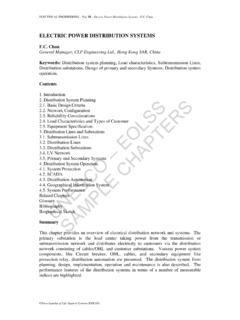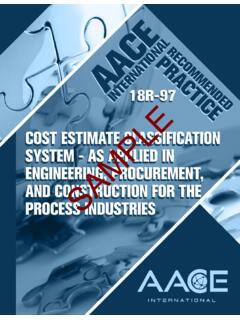Transcription of Underground Mining Methods and Equipment - EOLSS
1 UNESCO EOLSSSAMPLE CHAPTERSCIVIL ENGINEERING Vol. II - Underground Mining Methods and Equipment - S. Okubo and J. Yamatomi Encyclopedia of Life Support Systems ( EOLSS ) Underground Mining Methods AND Equipment S. Okubo and J. Yamatomi University of Tokyo, Japan Keywords: Mining method, Underground Mining , room-and-pillar Mining , sublevel stoping, cut-and-fill, longwall Mining , sublevel caving, block caving, backfill, support, ventilation, Mining machinery, excavation, cutting, drilling, loading, hauling Contents 1. Underground Mining Methods Classification of Underground Mining Methods Underground Operations in General Room-and-pillar Mining Sublevel Stoping Cut-and-fill Stoping Longwall Mining Sublevel Caving Block Caving 2. Underground Mining Machinery Glossary Bibliography Biographical Sketches Summary The first section gives an overview of Underground Mining Methods and practices as used commonly in Underground mines, including classification of Underground Mining Methods and brief explanations of the techniques of room-and-pillar Mining , sublevel stoping, cut-and-fill, longwall Mining , sublevel caving, and block caving.
2 The second section describes Underground Mining Equipment , with particular focus on excavation machinery such as boomheaders, coal cutters, continuous miners and shearers. 1. Underground Mining Methods Classification of Underground Mining Methods Mineral production in which all extracting operations are conducted beneath the ground surface is termed Underground Mining . Underground Mining Methods are usually employed when the depth of the deposit and/or the waste to ore ratio (stripping ratio) are too great to commence a surface operation. Once the economic feasibility has been verified, the most appropriate Mining Methods must be selected according to the natural/geological conditions and spatial/geometric characteristics of mineral deposits. Considerations include: 1. Spatial/geometric characteristics of the deposit concerned: the shape, size, thickness, plunge, and depth.
3 UNESCO EOLSSSAMPLE CHAPTERSCIVIL ENGINEERING Vol. II - Underground Mining Methods and Equipment - S. Okubo and J. Yamatomi Encyclopedia of Life Support Systems ( EOLSS ) 2. Strength of the hanging wall, footwall, and ore body. 3. Economic value of the ore and grade distribution within the deposit. The selection of Underground Mining Methods is primarily based on the geological/spatial setting of the deposit. Candidate Methods can therefore be chosen and ranked based on estimated operational/capital costs, production rates, availability of labors and materials/equipments, and environmental considerations. The method offering the most reasonable and optimized combination of safety, economics, and Mining recovery is then chosen. Reflecting the importance of ground support, Underground Mining Methods are categorized in three classes on the basis of the extent of support required: unsupported, supported, and caving.
4 Unsupported Methods are essentially naturally or self-supported and require no major artificial system of support to carry superincumbent loads, instead relying on the natural competence of the walls of the openings and pillars. This definition of unsupported Methods does not exclude the use of rock/roof bolts or light structural sets of timber or steel, provided that such artificial supports do not significantly alter the load-carrying ability of the natural structure. The followings are considered unsupported Methods : Room-and-pillar Mining Shrinkage stoping Sublevel stoping Of the unsupported Methods , room-and-pillar Mining is employed for extraction of flat-dipping and tabular deposits, whereas shrinkage and sublevel stoping are applied to vertical or steeply inclined ore bodies. Shrinkage stoping has in the past been very popular, particularly in non-coal Mining .
5 Gravity can be utilized for ore transportation and broken ore stored within the stope may function as a working platform and temporary wall supports. It was quite attractive in the period before mechanization became widespread, when small-scale operations on vein-type deposits prevailed. However, with rising costs, the scarcity of skilled labor and the trend toward mechanization, the method has been largely displaced by sublevel stoping and cut-and-fill. Sublevel stoping will therefore be the only unsupported Methods examined in detail here. Supported Methods require substantial amounts of artificial support to maintain stability in exploitation openings, as well as systematic ground control throughout the mine. Supported Methods are used when production openings (stopes) are not sufficiently stable to remain open during operation, but the opening required to be held open to prevent caving or surface subsidence.
6 In other words, the supported class is employed when the other two categories of Methods , unsupported and caving, are not applicable. The supported class of Mining Methods is intended for application under ground conditions ranging in competency from moderate to incompetent. In the design of artificial support systems to provide varying degrees of controlled wall closure and ground movement, an evaluation of load-carrying capacity of the natural rock structure is a prerequisite. The most satisfactory forms of artificial support are backfilling/stowing, timbers/stulls, cribs/packs, and hydraulic/frictional props. There are three specific Methods in the UNESCO EOLSSSAMPLE CHAPTERSCIVIL ENGINEERING Vol. II - Underground Mining Methods and Equipment - S. Okubo and J. Yamatomi Encyclopedia of Life Support Systems ( EOLSS ) supported class. Cut-and-fill stoping Stull stoping Square-set stoping Cut-and-fill and stull stoping are intended for moderately competent rock, whereas square-set stoping is suitable for the least competent rock.
7 Supported Methods have declined in use since World War II, primarily because cut-and-fill stoping is the only method that lends itself to mechanization. Stull stoping and square-set stoping are infrequently used and relatively unimportant today, because of excessive labor intensity and very low productivity, in addition to a scarcity of skilled work forces and available timber resources. Only cut-and-fill stoping will be described later in detail. Caving Methods are defined as those associated with induced, controlled, massive caving of the ore body, the overlying rock, or both. The exploitation workings in caving Methods are designed to collapse, with intentional caving of the ore and/or host rock. The three major caving Methods are: Longwall Mining Sublevel caving Block caving Longwall Mining is used in horizontal, tabular deposits (mainly coal), while the others have applications in inclined or vertical, massive deposits, almost exclusively metallic or nonmetallic.
8 Because the exploitation openings are intentionally destroyed in the progress of Mining , the caving class is truly unique. Rock mechanics principles are applied to induce caving rather than to prevent the occurrence of caving. Moreover, development openings have to be designed and located to withstand moving and caving ground. Surface subsidence is inevitable and must be allowed for in the case of sublevel and block caving. Production must be maintained at a steady and continuous level to avoid disruptions or stoppages in the caving activity. Highly advanced Mining technology as well as experienced management is indispensable to a successful caving operation. Underground Operations in General Figure 1 shows a schematic mine layout for an Underground mine as an explanation of common Mining terms. UNESCO EOLSSSAMPLE CHAPTERSCIVIL ENGINEERING Vol.
9 II - Underground Mining Methods and Equipment - S. Okubo and J. Yamatomi Encyclopedia of Life Support Systems ( EOLSS ) Figure 1: Example layout of an Underground mine An inclined shaft is excavated for transportation of personnel and supplies in addition to a vertical shaft for hoisting mined ore and a ventilation shaft for enhancing circulation of fresh air with the aid of a fan. Alternatively, an inclined shaft can be used for main ore transportation and ventilation, and the vertical shaft can act as the main thoroughfare for employees and materials. The functions of inclined and vertical shafts are usually versatile in Mining operations. Main levels are arranged for main haulage and connection between Underground key facilities. A small number of sublevels may be situated between main levels within a stoping area for production. Raises and winzes are either vertical or sub-vertical openings driven between one level and another or the surface.
10 Raises are driven upward, and winzes are driven downward. A ramp is an inclined opening connecting levels or stopes to enable the passage of vehicles and an orepass is a vertical or sub-vertical hole through which ore is transferred to lower levels. If backfilling (to fill mined-out spaces with rock, soil or tailings) is part of the Underground operation for improving Mining recovery, safety, and mitigating surface subsidence, a fill raise will be constructed for transporting backfill materials prepared at the backfill plant on the surface to Underground stopes. If necessary, additional ventilation raises will be driven to improve Underground climates. The primary operations required in Underground are rock breakage and material handling. If the target is sufficiently soft ( , coal and rock salt), mechanical excavation utilizing continuous miners, shearers, ploughs/plows, and so on, can be employed.
















